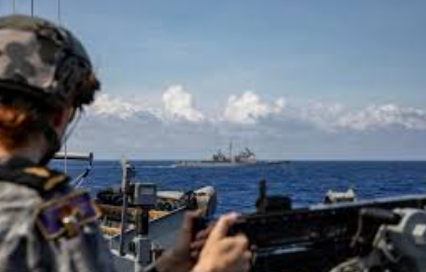Tensions Rise in South China Sea Dispute
China and the Philippines are engaged in escalating tensions over territorial claims in the South China Sea. Recent developments have heightened the conflict. The Philippines has defined its maritime boundaries, prompting a strong response from China. This situation reflects ongoing disputes over territorial sovereignty and maritime rights.
Recent Developments
On November 8, 2024, Philippine President Ferdinand Marcos signed two important laws. These laws outline the Philippines’ maritime boundaries and establish fixed routes for foreign vessels. China reacted swiftly, summoning the Philippine ambassador to express its discontent. The situation escalated further as China reaffirmed its claims over the Huangyan Dao, known as Scarborough Shoal.
China’s Position
China claims nearly the entire South China Sea. It has dismissed an international ruling that undermines its territorial claims. Beijing’s Foreign Ministry stated that its recent actions are lawful and align with international practices. They argue that the establishment of maritime boundaries is essential for marine management.
The Philippines’ Legislative Actions
The Maritime Zones Act delineates Philippine waters and establishes maritime entitlements per the U.N. Convention on the Law of the Sea. The Archipelagic Sea Lanes Act permits the President to designate specific sea and air routes for foreign passage. These laws aim to protect national security while asserting territorial rights.
China’s Reactions and Military Presence
China has firmly opposed the Philippines’ new laws. It claims these actions infringe on its territorial sovereignty. Chinese officials have accused the Philippines of frequent military incursions in disputed waters. In response, China has intensified its military presence, deploying coast guard and navy vessels to assert control.
Incidents at Sea
Tensions have led to confrontations at sea. Chinese vessels have reportedly rammed and blocked Philippine ships. Incidents involving water cannons and boarding attempts have resulted in damage and injuries. These aggressive tactics highlight the escalating nature of the conflict.
International Implications
The ongoing disputes have broader implications for regional stability. Other Southeast Asian nations also have claims in the South China Sea. The situation raises concerns about potential military confrontations and the impact on international shipping routes. The international community is closely monitoring developments.
The current trajectory suggests a continuation of heightened tensions. Both nations are unlikely to back down from their respective positions. Diplomatic efforts may be necessary to mitigate conflict and establish a framework for dialogue. The situation remains fluid and complex, with important geopolitical stakes involved.
Important Facts for Exams:
- Huangyan Dao – Huangyan Dao is the Chinese name for Scarborough Shoal. It is a strategic feature located closest to the Philippines in the South China Sea.
- Maritime Zones Act – The Maritime Zones Act defines the Philippines’ maritime boundaries. It establishes areas with maritime entitlements according to the U.N. Convention on the Law of the Sea.
- Archipelagic Sea Lanes Act – The Archipelagic Sea Lanes Act allows the President to designate specific sea and air routes. These routes facilitate foreign vessels and aircraft while ensuring national security.
Month: Current Affairs - November, 2024
Category: International / World Current Affairs


